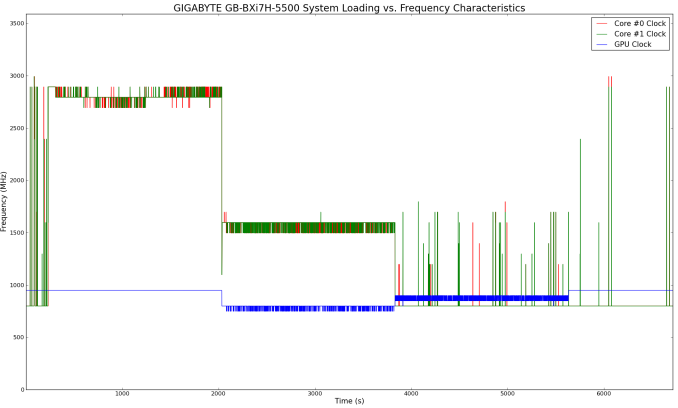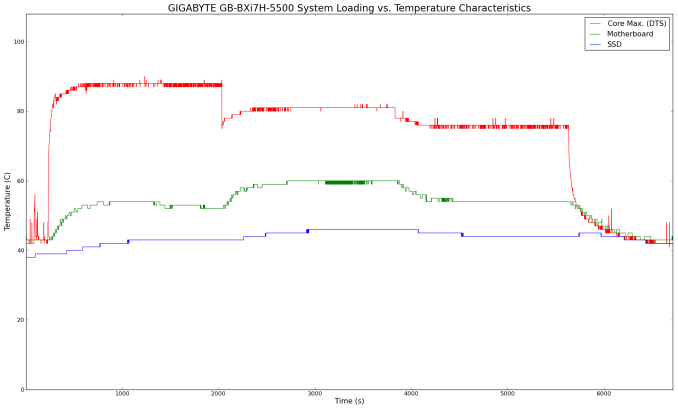GIGABYTE GB-BXi7H-5500 Broadwell BRIX Review
by Ganesh T S on January 29, 2015 7:00 AM ESTPower Consumption and Thermal Performance
The power consumption at the wall was measured with a 1080p display being driven through the HDMI port. In the graphs below, we compare the idle and load power of the GIGABYTE GB-BXi7H-5500 with other low power PCs evaluated before. For load power consumption, we ran Furmark 1.15.0 and Prime95 v28.5 together. The numbers are not beyond the realm of reason for the combination of hardware components in the machine.


The slightly higher base clocks in the Core i7-5500U (compared to the Core i7-4500U) are probably the reason for the Haswell-based unit appearing more power efficient than the Broadwell counterpart - but, make no mistake here - the Broadwell unit wins the performance per watt test quite easily.
The evaluation of the thermal performance was performed by monitoring the various clocks in the system as well as the temperatures with the unit when subject to the following workload. We start with the system at idle, followed by 30 minutes of pure CPU loading. This is followed by another 30 minutes of both CPU and GPU being loaded simultaneously. After this, the CPU load was removed, allowing the GPU to be loaded alone for another 30 minutes.
In the pure CPU loading scenario, the cpre frequencies stay well above the suggested base value of 2.4 GHz (indicating that GIGABYTE's trust in their cooling solution). The core temperature doesn't cross 90 C during this time (the junction temperature is 105 C). On the other hand, when the CPU and GPU are both loaded, the frequencies drop down to around 1.6 GHz for the cores. The GPU is advertised to run at a base clock of 300 MHz, with a turbo mode of 950 MHz. The actual frequency stays above 800 MHz comfortably throughout our stress test. In the absence of any CPU load, the cores drop down to 800 MHz. The temperatures are also below 80 C throughout the time that the GPU is loaded up.
All in all, the thermal solution is very effective. Given that the acoustic side-effects were not irksome (subjectively), we wonder if GIGABYTE has missed a trick by dialing down the overclocking and not allowing the full performance potential of the system to come through.












53 Comments
View All Comments
jaydee - Thursday, January 29, 2015 - link
I was hoping for a bit more here from Intel. Looking at the encoding, compressing, encrypting benchmarks, almost nothing was gained performance-wise, or in terms of power consumption.Flunk - Thursday, January 29, 2015 - link
Broadwell is an incremental update so it's not a big surprise.gonchuki - Thursday, January 29, 2015 - link
Doesn't even look incremental, more like a step revision of Haswell (just a node shrink and nothing else). It's the same processor Intel launched in 2013, but on a 14nm node.Refuge - Thursday, January 29, 2015 - link
Tick Tock Tick Tock.Although I've noticed their "Tick Tock" Has been slightly off cadence since their "Mobile First" strategy.
quophog - Friday, January 30, 2015 - link
No surprise really. No competition at all at the performance end. All their effort is going in to the ultra low power & cost end where ARM based architectures currently dominate. Very sad for everyone (except intel share holders) that AMD couldn't keep up with Intel R&D and fab spending.It's a long way off anyway, but I really hope Intel fab advantage doesn't let them eventually monopolise mobile procs too..
Haravikk - Friday, January 30, 2015 - link
Is that really such a bad thing? Making a smaller, much more power efficient processor without sacrificing any performance is still a pretty big accomplishment. While it might not make existing machines much more exiting, the really interesting part is what new things it makes possible.It's for this reason I hate this new Brix machine; it's the same horrific chassis as before, the with the same anaemic cooling. It should be possible for this to be entirely passively cooled, particularly if they want for a smaller, flatter, aluminium design.
eanazag - Friday, January 30, 2015 - link
Intel has done well, but with a competitive AMD we get better prices and more features. ARM has kept Intel moving, but look at the server market. Prices run from $200+ - north of $2000 for 2P systems. And Intel has the middle filled out too. Intel is charging whatever the hell they want there.eanazag - Friday, January 30, 2015 - link
It does look incremental in some benches. In others it is on par. For this type of system I would be leaning towards the 4770R. I don't care for the gaming performance on the 5500U. It is fine at 1280x1024/1366x768. I'd rather have the option to take a step up. The 4770R can do decent in 1600x900/1600x1000. For $750+ I'd like to be doing better. Broadwell Iris Pro may be what I'm hoping for.Otherwise, I'm a 5500U with a mobile GPU built-in - pricing and features may see which way I lean. I'm not a HTPC user.
nathanddrews - Thursday, January 29, 2015 - link
I don't think we should jump to judgment based upon multiple platforms with vastly different components. The closest competitor in this review is the 4500U, which the 5500U decimates in half the benchmarks, while leading it by at least a small margin in the rest. I'm looking forward to a more controlled, thorough review of Broadwell.I know that the gaming tests are set in stone and you try not to change them, but can we please drop the 1280x1024 test and replace it with 1280x720? It's 30% less taxing for these weak GPUs and is much more likely to be used by gamers - either on HDTVs, notebook displays (768p), and widescreen monitors. Nearly all 360/PS3 games are 720p, so many people are comfortable with that resolution and it scales to 1080p, 1440p, and 4K. It's just more realistic. No one games at 1280x1024 anymore unless they like pillarboxing and letterboxing at the same time. 720p and 1080p are really the only meaningful resolutions for these GPUs. You can save yourself some time, too...
ATC9001 - Thursday, January 29, 2015 - link
+1 for 720p resolution. If possible atleast add this to existing HTPC benchmarking, and of course when the benchmark is revamped for it's next iteraion, drop 1280x1024 completely!